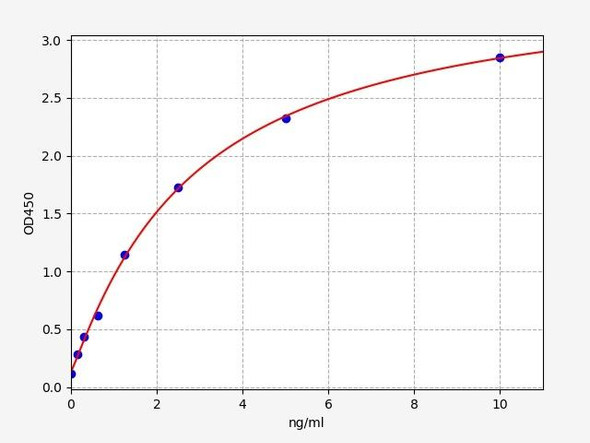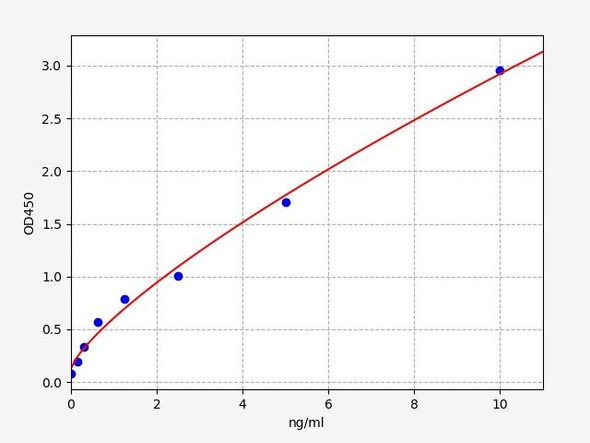Rat Immunology ELISA Kits 3
Rat PPAR gamma ELISA Kit
- SKU:
- RTFI01079
- Product Type:
- ELISA Kit
- Size:
- 96 Assays
- Uniprot:
- O88275
- Sensitivity:
- 0.094ng/ml
- Range:
- 0.156-10ng/ml
- ELISA Type:
- Sandwich
- Synonyms:
- PPAR-gamma, Pparg, NR1C3, Peroxisome prolifeRator-activated receptor gamma
- Reactivity:
- Rat
- Research Area:
- Cell Biology
Description
| Product Name: | Rat PPAR-gamma (Peroxisome ProlifeRator-Activated Receptor gamma) ELISA Kit |
| Product Code: | RTFI01079 |
| Size: | 96 Assays |
| Target: | Rat PPAR-gamma |
| Alias: | PPAR-gamma, Pparg, NR1C3, Peroxisome prolifeRator-activated receptor gamma |
| Reactivity: | Rat |
| Detection Method: | Sandwich ELISA, Double Antibody |
| Sensitivity: | 0.094ng/ml |
| Range: | 0.156-10ng/ml |
| Storage: | 4°C for 6 months |
| Note: | For Research Use Only |
| Recovery: | Matrices listed below were spiked with certain level of Rat PPAR-gamma and the recovery rates were calculated by comparing the measured value to the expected amount of Rat PPAR-gamma in samples. | ||||||||||||||||
| |||||||||||||||||
| Linearity: | The linearity of the kit was assayed by testing samples spiked with appropriate concentration of Rat PPAR-gamma and their serial dilutions. The results were demonstrated by the percentage of calculated concentration to the expected. | ||||||||||||||||
| |||||||||||||||||
| Intra-Assay: | CV <8% | ||||||||||||||||
| Inter-Assay: | CV <10% |
| Uniprot: | O88275 |
| UniProt Protein Function: | PPAR-gamma: a transcription factor, member of the nuclear hormone receptor superfamily. Receptor for hypolipidemic drugs and fatty acids. Preferentially expressed in adipocytes as well as in vascular smooth muscle cells and macrophage. Regulator of adipogenesis and lipid metabolism, modulates insulin sensitivity, cell proliferation and inflammation. Phosphorylated and inhibited by MAP kinase. Heterodimerizes with the retinoid X receptor. Interacts with NCOA6 coactivator, leading to a strong increase in transcription of target genes. Two splice-variant isoforms have been described. |
| UniProt Protein Details: | Protein type:DNA-binding; Nuclear receptor Chromosomal Location of Human Ortholog: 4q42 Cellular Component: cytoplasm; cytosol; Golgi apparatus; intracellular membrane-bound organelle; nucleus; perinuclear region of cytoplasm Molecular Function:alpha-actinin binding; arachidonic acid binding; chromatin binding; DNA binding; drug binding; enzyme binding; estrogen receptor binding; identical protein binding; ligand-dependent nuclear receptor activity; ligand-dependent nuclear receptor transcription coactivator activity; protein binding; protein phosphatase binding; retinoid X receptor binding; sequence-specific DNA binding; transcription activator binding; transcription factor activity; transcription factor binding Biological Process: brown fat cell differentiation; caspase activation; cell fate commitment; cell maturation; cellular response to insulin stimulus; diet induced thermogenesis; epithelial cell differentiation; fat cell differentiation; fatty acid metabolic process; fatty acid oxidation; glucose homeostasis; heart development; lipoprotein transport; long-chain fatty acid transport; low-density lipoprotein receptor biosynthetic process; monocyte differentiation; negative regulation of acute inflammatory response; negative regulation of cell growth; negative regulation of cell proliferation; negative regulation of collagen biosynthetic process; negative regulation of cytokine production; negative regulation of smooth muscle cell proliferation; negative regulation of telomerase activity; negative regulation of transcription from RNA polymerase II promoter; negative regulation of transcription, DNA-dependent; organ regeneration; placenta development; positive regulation of apoptosis; positive regulation of fat cell differentiation; positive regulation of fatty acid oxidation; positive regulation of oligodendrocyte differentiation; positive regulation of phagocytosis, engulfment; positive regulation of transcription factor activity; positive regulation of transcription from RNA polymerase II promoter; positive regulation of transcription, DNA-dependent; regulation of blood pressure; regulation of circadian rhythm; regulation of fat cell differentiation; regulation of gene expression; regulation of lipid metabolic process; regulation of transcription from RNA polymerase II promoter; regulation of transcription, DNA-dependent; response to caffeine; response to cold; response to dietary excess; response to drug; response to estrogen stimulus; response to food; response to light stimulus; response to lipid; response to low density lipoprotein stimulus; response to mechanical stimulus; response to organic cyclic substance; response to organic substance; response to retinoic acid; response to starvation; response to vitamin A; signal transduction; white fat cell differentiation |
| NCBI Summary: | ligand-activated transcription factor; mediates expression of genes involved in lipid metabolism [RGD, Feb 2006] |
| UniProt Code: | O88275 |
| NCBI GenInfo Identifier: | 223941854 |
| NCBI Gene ID: | 25664 |
| NCBI Accession: | NP_001138838.1 |
| UniProt Secondary Accession: | O88275,Q9QWG0, Q9R197, |
| UniProt Related Accession: | O88275 |
| Molecular Weight: | 54,471 Da |
| NCBI Full Name: | peroxisome proliferator-activated receptor gamma isoform 2 |
| NCBI Synonym Full Names: | peroxisome proliferator-activated receptor gamma |
| NCBI Official Symbol: | Pparg |
| NCBI Protein Information: | peroxisome proliferator-activated receptor gamma |
| UniProt Protein Name: | Peroxisome proliferator-activated receptor gamma |
| UniProt Synonym Protein Names: | Nuclear receptor subfamily 1 group C member 3 |
| Protein Family: | Peroxisome proliferator-activated receptor |
| UniProt Gene Name: | Pparg |
| Step | Procedure |
| 1. | Set standard, test sample and control (zero) wells on the pre-coated plate respectively, and then, record their positions. It is recommended to measure each standard and sample in duplicate. Wash plate 2 times before adding standard, sample and control (zero) wells! |
| 2. | Aliquot 0.1ml standard solutions into the standard wells. |
| 3. | Add 0.1 ml of Sample / Standard dilution buffer into the control (zero) well. |
| 4. | Add 0.1 ml of properly diluted sample ( Human serum, plasma, tissue homogenates and other biological fluids.) into test sample wells. |
| 5. | Seal the plate with a cover and incubate at 37°C for 90 min. |
| 6. | Remove the cover and discard the plate content, clap the plate on the absorbent filter papers or other absorbent material. Do NOT let the wells completely dry at any time. Wash plate X2. |
| 7. | Add 0.1 ml of Biotin- detection antibody working solution into the above wells (standard, test sample & zero wells). Add the solution at the bottom of each well without touching the side wall. |
| 8. | Seal the plate with a cover and incubate at 37°C for 60 min. |
| 9. | Remove the cover, and wash plate 3 times with Wash buffer. Let wash buffer rest in wells for 1 min between each wash. |
| 10. | Add 0.1 ml of SABC working solution into each well, cover the plate and incubate at 37°C for 30 min. |
| 11. | Remove the cover and wash plate 5 times with Wash buffer, and each time let the wash buffer stay in the wells for 1-2 min. |
| 12. | Add 90 µL of TMB substrate into each well, cover the plate and incubate at 37°C in dark within 10-20 min. (Note: This incubation time is for reference use only, the optimal time should be determined by end user.) And the shades of blue can be seen in the first 3-4 wells (with most concentrated standard solutions), the other wells show no obvious color. |
| 13. | Add 50 µL of Stop solution into each well and mix thoroughly. The color changes into yellow immediately. |
| 14. | Read the O.D. absorbance at 450 nm in a microplate reader immediately after adding the stop solution. |
When carrying out an ELISA assay it is important to prepare your samples in order to achieve the best possible results. Below we have a list of procedures for the preparation of samples for different sample types.
| Sample Type | Protocol |
| Serum: | If using serum separator tubes, allow samples to clot for 30 minutes at room temperature. Centrifuge for 10 minutes at 1,000x g. Collect the serum fraction and assay promptly or aliquot and store the samples at -80°C. Avoid multiple freeze-thaw cycles. If serum separator tubes are not being used, allow samples to clotovernight at 2-8°C. Centrifuge for 10 minutes at 1,000x g. Removeserum and assay promptly or aliquot and store the samples at-80°C. Avoid multiple freeze-thaw cycles. |
| Plasma: | Collect plasma using EDTA or heparin as an anti-coagulant. Centrifuge samples at 4°C for 15 mins at 1000 × g within 30 mins of collection. Collect the plasma fraction and assay promptly or aliquot and store the samples at -80°C. Avoid multiple freeze-thaw cycles.Note: Over haemolysed samples are not suitable for use with this kit. |
| Urine & Cerebrospinal Fluid: | Collect the urine (mid-stream) in a sterile container, centrifuge for 20 mins at 2000-3000 rpm. Remove supernatant and assay immediately. If any precipitation is detected, repeat the centrifugation step. A similar protocol can be used for cerebrospinal fluid. |
| Cell Culture Supernatant: | Collect the cell culture media by pipette, followed by centrifugation at 4°C for 20 mins at 1500 rpm. Collect the clear supernatant and assay immediately. |
| Cell Lysates: | Solubilize cells in lysis buffer and allow to sit on ice for 30 minutes. Centrifuge tubes at 14,000 x g for 5 minutes to remove insoluble material. Aliquot the supernatant into a new tube and discard the remaining whole cell extract. Quantify total protein concentration using a total protein assay. Assay immediately or aliquot and store at ≤ -20°C. |
| Tissue Homogenates: | The preparation of tissue homogenates will vary depending upon tissue type. Rinse tissue with 1X PBS to remove excess blood & homogenizein 20ml of 1X PBS (including protease inhibitors) and store overnight at ≤ -20°C. Two freeze-thaw cycles are required to break the cell membranes. To further disrupt the cell membranes you can sonicate the samples. Centrifuge homogenates for 5 mins at 5000xg. Remove the supernatant and assay immediately or aliquot and store at -20°C or-80°C. |
| Tissue Lysates: | Rinse tissue with PBS, cut into 1-2 mm pieces, and homogenize with a tissue homogenizer in PBS. Add an equal volume of RIPA buffer containing protease inhibitors and lyse tissues at room temperature for 30 minutes with gentle agitation. Centrifuge to remove debris. Quantify total protein concentration using a total protein assay. Assay immediately or aliquot and store at ≤ -20 °C. |
| Breast Milk: | Collect milk samples and centrifuge at 10,000 x g for 60 min at 4°C. Aliquot the supernatant and assay. For long term use, store samples at -80°C. Minimize freeze/thaw cycles. |






